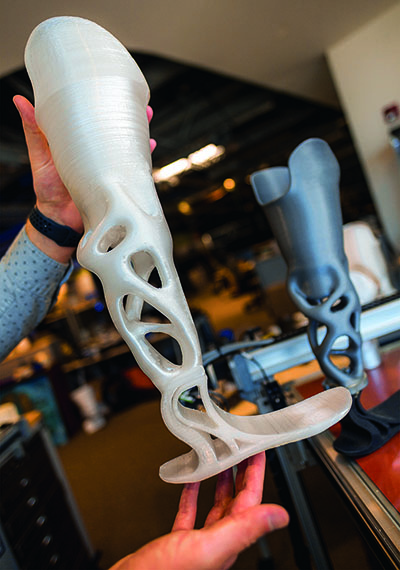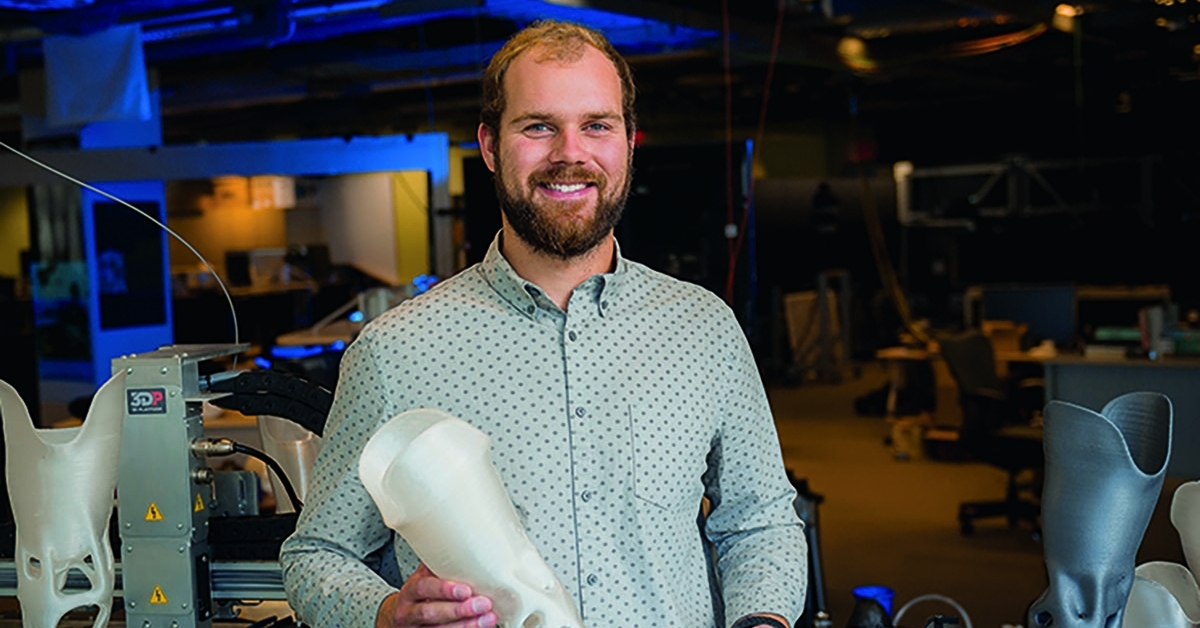A Second Chance
Alumni startup aims to make 3D-printed prostheses accessible and affordable.
Published Date
Story by:
Topics covered:
Share This:
Article Content
This story was published in the Fall 2022 issue of UC San Diego Magazine.
Every quarter, you’ll find UC San Diego engineers Joshua Pelz, MS ’19, PhD ’22 and Luca De Vivo ’16, MS ’20, PhD ’21, as well as prosthetics specialist Herb Barrack, in Ensenada, Mexico. They have traveled to give amputees a second chance at mobility with free, 3D-printed, custom-made prostheses from their startup, LIMBER Prosthetics & Orthotics Inc.
“I found my passion for this project when we visited a clinic in Mexico and saw the huge impact our technology can have,” says Pelz, LIMBER co-founder.
The team takes scans of the amputees’ residual limbs with smartphones, then they bring the scans back to UC San Diego. They use them to build a digital model of the amputated limb and a compatible prosthesis. Then, using a 3D printer the team developed, the prosthesis is printed in just 12 hours. The team returns to Mexico with the prosthesis, and the fit is perfected and fine-tuned to the recipient.
The World Health Organization estimates that there are 40 million amputees globally and 95 percent make do without the use of a prosthetic limb. Amputations are caused by trauma, infections, diabetes or other medical problems. Traditionally, a model of the residual limb is hand-carved by a specialist, a time-consuming process that is expensive and can’t be replicated.
“They are like sculptors,” says De Vivo. “And there are not enough of them.”
Patients must undergo repeated visits to see these specialists to ensure the proper shape and fit of the prosthetic.
By using a combination of personalized scans as well as digital designs and 3D printing on a large scale, the LIMBER team believes it could reduce the cost of a prosthesis by anywhere from 50% to 90%, delivering prosthetics much faster to those who need them.

Diana Zambrano, a San Diego resident and amputee who helped test the devices, says the company could revolutionize access to prosthetics for amputees. “Mobility is key,” she says. “LIMBER can print out a leg in a day, and right away you have a leg to walk on. It’s amazing.”
“Materials for prosthetics have improved dramatically over the last 35 years, from wood to space-age materials to 3D printing,” say Barrack, a certified prosthetist and orthotist. LIMBER devices are made from water-proof materials—in contrast to traditional prosthetics made of carbon fiber and metal—and are a combination of nylon and nylon filled with chopped carbon fiber. By 3D printing with these two materials, the team can vary the stiffness of the limb, such as by making the food more or less flexible.
Inspired by Nature
As a structural engineering student at UC San Diego, De Vivo became interested in the connection between natural structures and materials science. He furthered that interest as a doctoral student. He says that the design of the LIMBER prosthesis is inspired by the structure of the Cholla cactus, which has a wooden skeleton that can withstand harsh desert conditions and hurricane-force winds: A cylinder of wooden fibers crisscross at a 45-degree angle with oval spaces between them, like a chain-link fence. This open space allows for optimum flexibility—to bend or rotate in windy conditions—along with increased strength. These naturally occurring features were incorporated into the design.
UC San Diego Roots
The project started in 2016 in the research group of Falko Kuester, a professor in the Department of Structural Engineering. Dubbed the Limber Integrative Imaging Modeling Manufacturing for Bold Exoskeleton Research project, or LIMBER, the project’s goal was to bring together imaging, modeling, simulation testing and 3D printing to create low-cost, one-piece prosthetics that could be tailored specifically to match user needs. Preliminary, proof-of-concept studies with lower-limb amputees demonstrated the potential of this approach. The project was housed in the Qualcomm Institute at UC San Diego.
“It is truly inspiring to work with enthusiastic and innovative students in the classroom and the lab and see their ideas and careers take flight,” says Kuester.
Today, LIMBER is part of the medical technology accelerator in the Institute for the Global Entrepreneur (IGE) at the UC San Diego Jacobs School of Engineering. It is also part of UC San Diego’s Basement startup accelerator. The company will soon start raising a seed round of funding.
Next Steps
LIMBER has now partnered with UC San Diego to raise funds to manufacture 100 prostheses for Ukrainian amputees. This new initiative comes after LIMBER successfully shipped five custom prostheses to Ukraine.
You May Also Like
UC San Diego is Strengthening U.S. Semiconductor Innovation and Workforce Development
Technology & EngineeringStay in the Know
Keep up with all the latest from UC San Diego. Subscribe to the newsletter today.





